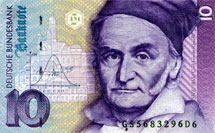

The German 10-Mark note (pre-Euro) featured Carl Friederich Gauß and his equation describing the “normal curve” of probability distribution.
A glorious mix of drama, inspiration, insight, good and bad judgement,
hard work, and sometimes sheer luck mark the path of scientific discovery.
This is seldom more clearly illustrated than in the quest to understand
one of nature’s most remarkable phenomena, magnetism. The hidden
source of its almost magical powers of attraction has been sought for over
two thousand years. In this odyssey, creative human beings have moved from
superstition to certainty and synthesis, from an era when answers to basic
questions could only be imagined to the present time, in which scientists
are able to incorporate magnetism into a great scheme of the basic forces
in the universe. To see how progress was made is to watch the evolution
of science. And by recognizing how scientists moved from superstition to
synthesis, we are reminded a little of ourselves, as we struggle to dig
out from under the welter of beliefs and prejudices about the ways of the
world and strive for a clearer understanding of the mystery of our existence.
There is every indication that once our curiosity is aroused, and given
enough time, the human intellect can and does discover the answers to its
questions. How this progress was manifested in the case of magnetism will
be the theme of Hidden Attraction.
The saga of discovery that led to the solution
of the mystery of magnetism began over two thousand years ago, when explanations
of natural phenomena could only take the form of beliefs rooted in fantasy.
But, then, after many centuries individuals began to challenge dogma and
superstition, and their questioning slowly and inevitably led to experimentation.
That turned out to be the reliable way to get at the truth about the reality
that underlies the appearance. The transition to experiment marked the
birth of the scientific era, about four hundred years ago.
I will argue that without the stunning
progress made during the last several centuries in understanding the nature
of magnetism, our modern technological civilization would not yet have
come into existence. Every facet of the civilized world rests,
ultimately, on the widespread availability of electricity to drive the
machines of industry. We would never have learned to produce electricity
if it were not for the profound insights that arose from the study of magnetism.
As a result of ever-deeper probing into the nature of reality, we have
even learned to reach out and sense magnetism between the stars.
Hidden Attraction concerns an adventure
of the mind, and these chapters have been conceived to trigger your imagination
and stimulate your curiosity. An adventure of discovery underlies
all of science, something that is easily ignored, in large part
because of the mushrooming welter of facts that overflow the time available
for their communication. Those who make judgements about what should
be taught to stay “up-to-date” tend to rule against the human
historical side of science. This is sad. As a result, the curricula of
our schools lose touch with the dramatic and exciting roots of human thought.
Verschuur, Gerrit L. “Hidden Attraction: The Mystery and History of Magnetism”, Oxford University Press 1993, pp. v-vi.

